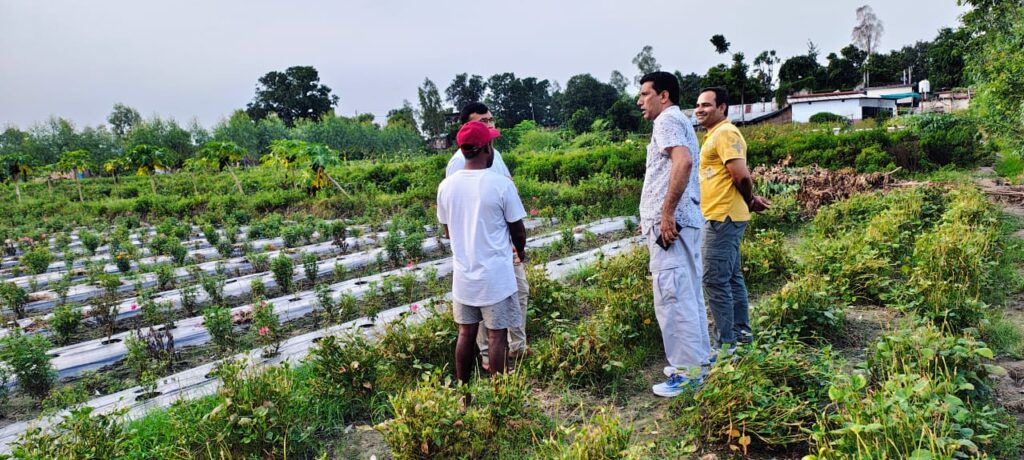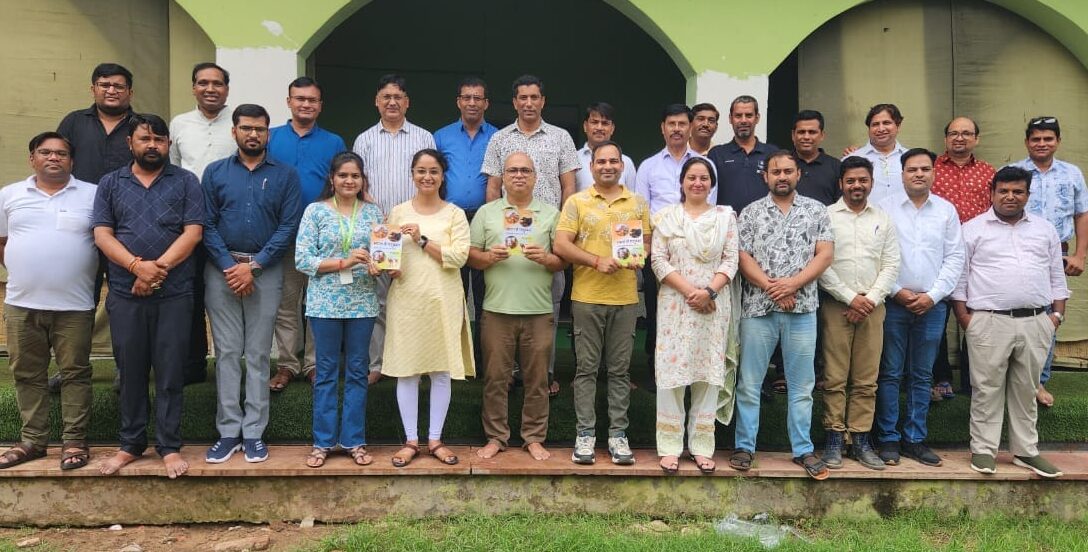Udaipur : Today, we have an exclusive interview with Naresh Kumar Nain, the mind behind “Bharat Me Pashudhan”. As a dedicated rural development professional, Naresh’s experiences working closely with farming communities inspired him to create this comprehensive Hindi resource on livestock management. The book addresses a crucial knowledge gap, equipping farmers, animal husbandry workers, and rural professionals with essential insights for sustainable livestock practices.
Inspiration for the Book : Where did you find the inspiration to write “Bharat Me Pashudhan”? Did your personal experiences influence this book in any way?
Ans : As I work in the rural development sector with farming communities, where livestock is one of the major sources of livelihood for farmers, I realized that despite livestock’s significant contribution to rural livelihoods, there was limited resource material for farmers to access appropriate knowledge about rearing and management practices. This prompted me to develop a comprehensive book on livestock, especially in Hindi, to help farming communities, animal husbandry workers, practitioners, and professionals in the sector.
Importance of Livestock : What do you believe is the greatest contribution of livestock to the Indian economy?
Ans : The livestock sector plays a crucial role in the Indian economy, significantly contributing to the livelihoods of approximately two-thirds of the rural population. It provides employment to nearly 8.8% of India’s population. With a vast livestock resource, the sector contributes 4.11% to the national GDP and 25.6% to the agricultural GDP. India is one of the largest milk producers globally, with its dairy sector making a vital contribution to the economy and providing employment to millions. Livestock also supports agricultural ecosystems by supplying fertilizers and enhancing farming productivity, thus contributing to poverty alleviation and food security. Furthermore, it serves as a source of income diversification and acts as a buffer against economic shocks, making it integral to India’s socio-economic structure and rural development efforts.
Management Techniques : In your book, what specific techniques or methods for livestock management do you consider to be the most effective?
Ans : The book provides an in-depth analysis of animal husbandry’s role in the Indian economy, focusing on buffalo, cow, goat, chick, and camel production. It covers various aspects, from traditional practices to modern technological advancements, and describes the different breeds found in India, particularly buffaloes, cows, goats, camels, and poultry. Detailed descriptions of their characteristics, production quality, physical traits, origin, and geographical specifics are included. The book serves as a resource for livestock keepers, helping them manage their animals and improve production. It explains various livestock production models useful for enhancing and strengthening livelihoods. Dedicated chapters cover rearing and management practices and indigenous knowledge for curing livestock using locally available materials.
Government Policies : Do you think there is a need for improvement in the government policies implemented for livestock development in India?

Ans : Yes, government policies for livestock development in India need improvement to better support farmers. Key reforms should include promoting high-yield cattle and animals through breeding programs, ensuring widespread access to affordable vaccinations, and creating robust livestock insurance schemes to protect farmers from financial loss. Additionally, the government should provide technical and financial support for commercial livestock farming, encouraging small and marginal farmers to scale up operations. Enhancing these areas can boost productivity, improve farmers’ incomes, and contribute to a more sustainable and profitable livestock sector. Livestock disease outbreaks, like the recent lumpy skin disease, have caused significant losses for farmers. To prevent such crises, policy interventions should focus on strengthening veterinary infrastructure, ensuring timely vaccinations, and raising awareness about preventive measures. Establishing disease surveillance systems, compensating affected farmers, and promoting insurance schemes can mitigate economic losses and ensure the long-term sustainability of livestock farming. Furthermore, artificial insemination services can be enhanced using the latest techniques to prioritize the production of female calves exclusively.
Sustainable Development : In the context of sustainable development, what measures do you recommend for the conservation of livestock?
Ans : For sustainable development, livestock conservation measures should focus on improving production systems to enhance food security, nutrition, and industry. Key actions include promoting sustainable grazing, improving feed efficiency, managing animal health, and breeding resilient livestock. These practices ensure environmental sustainability and economic viability. Collaborating with stakeholders, including governments and NGOs, to achieve Sustainable Development Goals (SDGs) strengthens capacity building, innovation, and resource-sharing for long-term impacts on livestock sustainability and global food systems. Natural farming complements livestock development by promoting organic practices, improving animal health, and enhancing soil fertility through integrated systems. It reduces input costs, boosts productivity, and aligns with sustainable agriculture goals.
Community Participation : How do you view the importance of community participation in livestock development?

Ans : Community participation is crucial for the success of livestock development programs. India has witnessed the positive impact of this approach, notably in the Green Revolution and Operation Flood programs. Civil society organizations have pioneered the Pashu Sakhi model, empowering women as livestock paravets, significantly boosting livestock productivity. The government is now scaling this up through the A-Help workers initiative. Additionally, large-scale dairy and broiler production have greatly contributed to the food value chain and economic transformation, demonstrating the power of community-driven initiatives in fostering sustainable livestock development.
Future Directions : What new trends or challenges do you anticipate in the field of livestock management and development in the future?
Ans : In the future, livestock management will face several emerging trends and challenges. With a growing population, the demand for livestock products will surge, but production may struggle to keep pace due to rising costs. The traditional practice of livestock rearing in rural areas is diminishing as families consolidate operations to manage costs. Key challenges will include ensuring access to quality feed and fodder, improving medical care through timely vaccinations and deworming, and addressing the rising need for advanced veterinary services. Sustainable practices, efficient resource use, and technology-driven solutions will be essential for meeting future demands in the livestock sector.
Purpose of the Book : What key message do you aim to convey to readers through this book?

Ans : The purpose of this book is to serve as a comprehensive guide for readers looking to enhance their knowledge of the livestock sector. It focuses on capacity building, knowledge enhancement, and fostering sustainable livestock ecosystems. Readers will gain valuable insights and practical tools to improve livestock management practices and contribute to a more resilient and productive livestock industry.
Research Process : What was your research process like for this book?
Ans : This book is a culmination of my extensive work with farming communities across Rajasthan, Madhya Pradesh, Uttar Pradesh, and Uttarakhand. Drawing on theoretical insights and practical knowledge, it merges the wisdom of experienced livestock practitioners with best practices from online research, manuals, and documents. The content reflects a unique combination of theory and hands-on practices, offering a comprehensive guide for both practitioners and researchers. By integrating field experiences with well-researched methodologies, the book provides actionable insights that can empower farming communities and enhance sustainable livestock management across diverse regions.
Impact of the Book : How do you believe the book “Bharat Me Pashudhan” can positively impact rural communities?
Ans : The book “Bharat Me Pashudhan” can greatly benefit communities by enhancing the knowledge and skills of farmers, practitioners, and animal husbandry workers. It promotes improved livestock production systems, enabling better management, health, and productivity of livestock. By fostering capacity building, the book supports the development of livestock-based enterprises, driving job creation and economic transformation in rural areas. Furthermore, it empowers India to become a global leader in livestock production, contributing to economic growth and food security. This initiative can significantly uplift rural economies and advance India’s position as a livestock superpower on the global stage.

About Author
Naresh Kumar Nain is the Program Director at Manjari Foundation in Udaipur, Rajasthan, with nearly two decades of experience in rural development. He has worked extensively in the red corridor regions of Madhya Pradesh and Rajasthan, collaborating with various organizations. Naresh holds a Master’s in English Literature and an MBA from Kurukshetra University, and he has completed development courses at Wageningen University in the Netherlands, with additional studies in South Africa and Indonesia.
His expertise includes designing and implementing livelihood projects funded by corporate and governmental initiatives, focusing on community mobilization and establishing Self-Help Groups (SHGs) and federations. Notably, he contributed to replicating the SHG model in Mali and Senegal.
Recognized as a National Resource Person by the National Institute of Rural Development and Panchayati Raj (NIRDPR), Naresh supports state Rural Livelihood Missions in executing the National Rural Livelihood Mission project. He is also a Certified Sustainability Assessor accredited by the Confederation of Indian Industry (CII) and has actively contributed to women’s empowerment initiatives and livestock development in Rajasthan.


Bharat Me Pashudhan by Naresh Kumar Nain offers an essential guide on sustainable livestock management in rural India. Written in Hindi, it empowers farmers with practical knowledge on modern and traditional practices for rearing buffaloes, cows, goats, and more. With insights on government policies, sustainable development, and community involvement, this book is a comprehensive resource that strengthens rural livelihoods and enhances India’s livestock industry. A must-read for Development Professionals.
यह पुस्तक श्री Naresh Nain जी द्वारा लिखी गई है,जो मंजरी फाउंडेशन Manjari Foundation में प्रोग्राम डायरेक्टर है।पशुपालन का भारत वर्ष ही नही पूरे विश्व के लिए आजीविका का एक महत्वपूर्ण साधन रहा है।यह पुस्तक पशुपालको के लिए एक तरह का विश्वकोश है,मैं एक किसान परिवार से हूँ और मेरा परिवार घरेलू दुग्ध की घरेलू ज़रूरतो के लिए पशुपालन वर्षों से करता था लेकिन 2000 वर्ष के पशचात हम वहवसायक रूप से इस काम में कार्यरत है।
इस पूरे कार्यकल में मैने ऐसी पुस्तक नही देखी जो पशुधन के बारे इस प्रकार जानकारी प्रदान करती हो।मैं श्री नैन जी को बधाई देता हूं और उनका धन्यवाद करता हूँ जिन्होंने इतनी अच्छी जानकारी हम लोगों तक पहुंचाई।
मैं आछा करता हूँ कि यह पुस्तक देश की अन्य भाषओं में भी संपादित हो और इस व्यवसाय से जुड़े लोग लाभान्वित हों।
एक बार पुनःश्री नरेश नैन जी का धन्यवाद।
#गुरमीत_सिंह_सेखों
#ਗੁਰਮੀਤ_ਸਿੰਘ_ਸੇਖੋਂ
#Sekhon_Farm_Khappian wali
यह केवल पुस्तक मात्र ही नहीं अपितु ग्रामीण भारत के दृष्टिकोण में लेखक के विगत वर्षों का अनुभव, अनुसंधान और विकास तथा परीक्षण और त्रुटियों का आधारभूत अनुभव का समायोजन है वाकई यह पुस्तक विद्यार्थियों,किसानों और इस क्षेत्र में कार्यरत एनजीओ, सीएसआर संस्थानों के लिए उपयोगी है।
Very good and useful
Naresh Nain is an extraordinary human being and passionate development professional .I got the book recently. Excellent one. The book is nicely penned, this will help to academia, reserchers, practitioners, farmers and others. Thanks a lot for such in-depth resource.
All the best Naresh ji